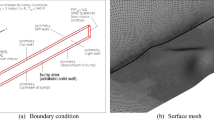Abstract
The primary objective of this study is to evaluate the accuracy of using computational fluid dynamics (CFD) turbulence models to predict entropy generation rates in bypass transitional boundary layers flows under zero and adverse pressure gradients. Entropy generation rates in such flows are evaluated employing the commercial CFD software, ANSYS FLUENT. Various turbulence and transitional models are assessed by comparing their results with the direct numerical simulation (DNS) data and two recent CFD studies. A solution verification study is conducted on three systematically refined meshes. The factor of safety method is used to estimate the numerical error and grid uncertainties. Monotonic convergence is achieved for all simulations. The Reynolds number based on momentum thickness, Re θ , skin-friction coefficient, C f , approximate entropy generation rates, S‴, dissipation coefficient, C d , and the intermittency, γ, are calculated for bypass transition simulations. All Reynolds averaged Navier-Stokes (Rans) turbulence and transitional models show improvement over previous CFD results in predicting onset of transition. The transition Sst k- ω 4 equation model shows closest agreement with DNS data for all flow conditions in this study due to a much finer grid and more accurate inlet boundary conditions. The other Rans models predict an early onset of transition and higher boundary layer entropy generation rates than the DNS shows.
Similar content being viewed by others
References
WALSH E. J., MCELIGOT D. M. and BRANDT L. et al. Entropy generation in a boundary layer transitioning under the influence of freestream turbulence[J]. Journal of Fluids Engineering, 2011, 133(6): 061203.
ZAKI T. A., DURBIN P. A. Mode interaction and the bypass route to transition[J]. Journal of Fluid Mechanics, 2005, 531(1): 85–111.
MCELIGOT D. M., WALSH E. J. and LAURIEN E. et al. Entropy generation in the viscous parts of turbulent boundary layers[J]. Journal of Fluids Engineering, 2008, 130(6): 061205.
SPALART P. R. Direct simulation of a turbulent boundary layer up to Re θ=1 410[J]. Journal of Fluid Mechanics, 1988, 187(1): 61–98.
SPALART P. R. Numerical study of sink-flow boundary layers[J]. Journal of Fluid Mechanics, 1986, 172(1): 307–328.
ROTTA J. Turbulent boundary layers in incompressible flow[J]. Progress in Aerospace Sciences, 1962, 2(1): 1–95.
MCELIGOT D. M., WALSH E. J. and LAURIEN E. et al. Entropy generation in the viscous layer of a turbulent channel flow[R]. Idaho National Laboratory (INL), 2006.
ABE H., KAWAMURA H. and MATSUO Y. Direct numerical simulation of a fully developed turbulent cha-nnel flow with respect to the reynolds number dependence[J]. Journal of Fluids Engineering, 2001, 123(2): 382–393.
KRAUSE E., OERTEL H. J. and SCHLICHTING H. Boundary-layer theory[M]. New York, USA: Springer, 2004.
MCELIGOT D. M., NOLAN K. P. and WALSH E. J. Effects of pressure gradients on entropy generation in the viscous layers of turbulent wall flows[J]. International Journal of Heat and Mass Transfer, 2008, 51(5–6): 1104–1114.
TSUKAHARA T., SEKI Y. and KAWAMURA H. et al. DNS of turbulent channel flow at very low Reynolds numbers[C]. Proceedings of the 4th International Symposium on Turbulence and Shear Flow Phenomena. Williamsburg, USA, 2005, 935–940.
WALSH E. J., MCELIGOT D. M. A New correlation for entropy generation in low Reynolds number turbulent shear layers[J]. International Journal of Fluid Mechanics Research, 2009, 36(6): 566–572.
ABE H., KAWAMURA H. and MATSUO Y. Surface heat-flux fluctuations in a turbulent channel flow up to Re τ = 1020 with Pr = 0.025 and 0.71 [J]. International Journal of Heat and Fluid Flow, 2004, 25(3): 404–419.
HOYAS S., Jiménez J. Scaling of the velocity flu-ctuations in turbulent channels up to Re = 2003 [J]. Physics of fluids, 2006, 18(1): 011702.
SCHLATTER P., BRANDT L. and De LANGE H. et al. On streak breakdown in bypass transition[J]. Physics of fluids, 2008, 20(1): 101505.
BRANDT L., SCHLATTER P. and HENNINGSON D. S. Transition in boundary layers subject to free-stream turbulence[J]. Journal of Fluid Mechanics, 2004, 517: 167–198.
NOLAN K., ZAKI T. A. Conditional sampling of tran-sitional boundary layers in pressure gradients[J]. Journal of Fluid Mechanics, 2013, 728: 306–339.
GHASEMI E., MCELIGOT D. and NOLAN K. et al. Entropy generation in a transitional boundary layer region under the influence of freestream turbulence using transitional Rans models and DNS[J]. International Communications in Heat and Mass Transfer, 2012, 41(1): 10–16.
GHASEMI E., MCELIGOT D. M. and NOLAN K P. et al. Effects of adverse and favorable pressure gradients on entropy generation in a transitional boundary layer region under the influence of freestream turbulence[J]. International Journal of Heat and Mass Transfer, 2014, 77(1): 475–488.
ANSYS. “Fluent theory guide v14.0.0.”[R]. 2011.
XING T., BHUSHAN S. and STERN F. Vortical and turbulent structures for KVLCC2 at drift angle 0, 12, and 30 degrees[J]. Ocean Engineering, 2012, 55(3): 23–43.
XING T., STERN F. Closure to “Discussion of “Factors of safety for Richardson extrapolation”” (2011, Journal of Fluids Engineering, 133, 115501)[J]. Journal of Fluids Engineering, 2011, 133(11): 115502.
XING T., STERN F. Factors of safety for richardson extrapolation[J]. Journal of Fluids Engineering, 2010, 132(6): 061403.
WILSON R. V., STERN F. and COLEMAN H. W. et al. Comprehensive approach to verification and validation of Cfd simulations-Part 2: Application for rans simulation of a cargo/container ship[J]. Journal of Fluids Engineering, 2001, 123(4): 803–810.
ANSYS. “Fluent user guide v14.0.0.”[R]. 2011.
XING T., GEORGE J. Quantitative verification and validation of large eddy simulations[C]. Asme 2014 Verification and Validation Symposium. Las Vegas, Nevada, USA, 2014.
XING Tao. A general framework for verification and validation of large eddy simulations (keynote speaker)[C]. Proceedings of the 13th National Congress on Hydrodynamics and 26th Conference on Hydrodynamics. Qingdao, China, 2014, 40–58.
Author information
Authors and Affiliations
Corresponding author
Additional information
Biography: GEORGE Joseph (1986-), Male, Master Candidate
Rights and permissions
About this article
Cite this article
George, J., Owen, L.D., Xing, T. et al. Entropy generation in bypass transitional boundary layer flows. J Hydrodyn 26, 669–680 (2014). https://doi.org/10.1016/S1001-6058(14)60075-5
Received:
Revised:
Published:
Issue Date:
DOI: https://doi.org/10.1016/S1001-6058(14)60075-5



